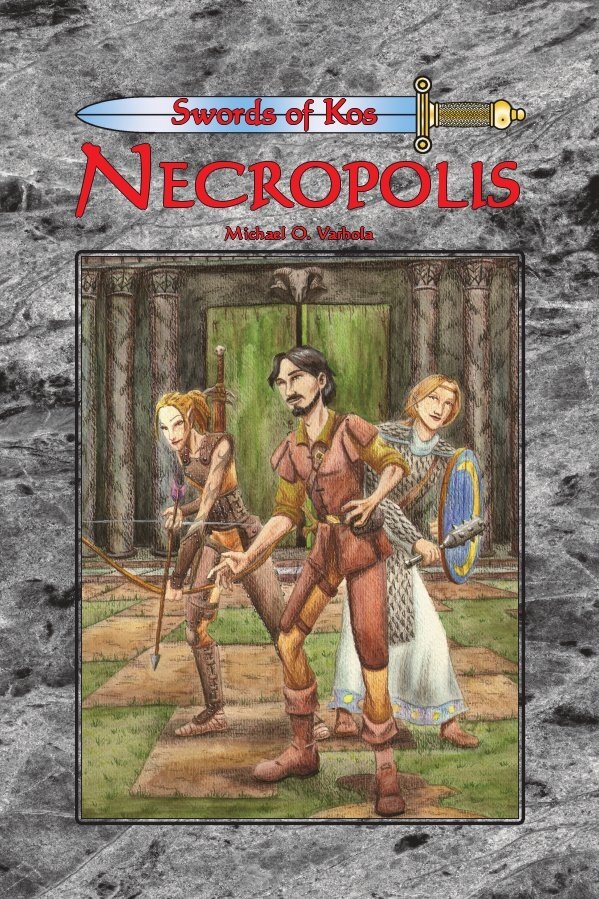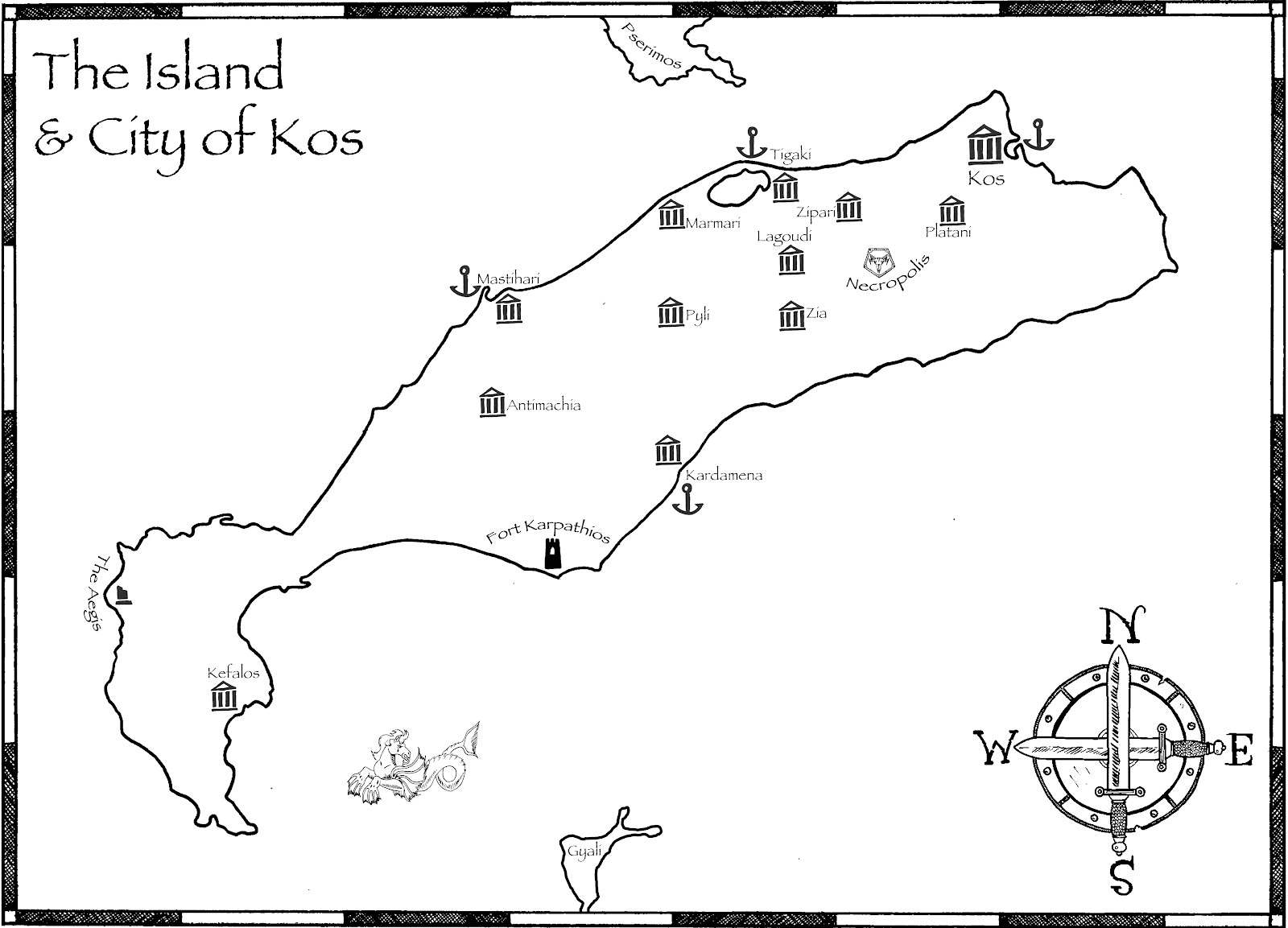'Swords of Kos: Necropolis' Chapter 1

Following is Chapter 1 of Swords of Kos: Necropolis, a fantasy novel written by author Michael O. Varhola and published by Skirmisher Publishing LLC. Join adventurers Paros the rogue and Parthenia the Elven barbarian as they see the city of the dead for the first time ...
Following is Chapter 1 of Swords of Kos: Necropolis, a fantasy novel written by author Michael O. Varhola and published by Skirmisher Publishing LLC.
Paros could only venture a guess as to how many graves the forsaken burial ground in the little valley before him contained. North to south, it ran about a half mile and, from where he stood beside the wrought-iron fence that zigzagged along its eastern edge, it stretched about a quarter mile to the base of the hills that surrounded it. The rolling, broken ground of this unkempt area was heavily overgrown with grass, vines, copses of scrubby little oaks and brushy gray-green juniper, great clumps of flowers in every color, and probably every other sort of vegetation native to the island of Kos. Obelisks, statues of patron deities, and other stones marking the gravesites of families and individuals lay broken and tumbled amongst the rampant growth, and mausoleums of every size were interspersed throughout.
Paros did not know the extent to which this place had been looted over the century since it was last known to have been used but there were undoubtedly hundreds, perhaps even thousands, of graves that had not yet been pillaged. And they were not even the object of their quest, which was marked by the small, columned temple of black marble that he could see halfway up one of the hills at the other end of the cemetery. And there was no telling what else might be hidden within this wild, desolate place. ...
A firsthand look at the necropolis revealed the truth of much of what Paros had read about it. He noted, for example, the placement of the largest and most elaborate tombs and cenotaphs upon the highest and most attractive spots which, he recalled, had been claimed by the most prominent families, leaving less desirable ones to lesser clans. Paros could also clearly see the chaotic nature of the cemetery, which corresponded to the flow and features of the natural terrain rather than any prevailing central organization; pockets of the place had been laid out on grids, circles, or other patterns, but much of this had been undone or obscured by a century of wild growth and decay. At some point — some hundreds of years after people had begun using the place as a burial ground and perhaps a century-and-a-half before Paros and Parthenia arrived at it — the priests of Hades Polydegmon, “He Who Receives Many,” arrived and built the dark hillside temple and began to adapt the caves beneath it into catacombs. They were said to have invoked the power of their dread deity in their labors and to have made it into a compelling representation of the underworld. And, beyond the innumerable and relatively modest graves and mausoleums, these extensive subterranean catacombs were the true gem of the place and were said to have been among the largest and richest known to the people of Kos.
“That is what we’re here for, Parthenia,” Paros said in a low voice to the savage-looking Elven woman beside him as he pointed toward the black marble structure that loomed over the necropolis. It had only taken the two of them about four hours to make their way up into the wooded hills southwest of Kos city and, although they were now somewhat less than six miles from the bustling capital, there was no sign of habitation or activity. It was only a little past noon and the rogue was eager to begin exploring the funereal edifice. 
Bow in hand, Parthenia stepped through the gate onto the grounds of the necropolis. As Paros came up beside her, he could see that she had narrowed her almondine eyes and was scanning the broken, overgrown area that surrounded them. Good; keeping them alive was her primary job and he was glad to see that she was doing it.
Rather than head in the direction of the hillside temple, the Elven woman instead bore to their left and moved toward a mausoleum a bit less than a hundred feet inside the gates. Upon reaching it, she scrambled up a plant-choked pile of earth that had built up along one side of the structure, and then clambered onto its peaked roof. Paros could see that she was trying to improve upon their limited visibility and gain a better sense for the lay of the land.
While Parthenia scanned the desolate burial ground for hazards, Paros took the opportunity to regard her unobserved and reflect upon the sort of woman to which he was attracted. Parthenia looked like a bronze statue of an idealized Amazon come to life, with a lean compact frame, small high breasts, buttocks like an unripe peach, and lithe rippling muscles covered with numerous obscure tribal tattoos. Her narrow, lozenge-shaped Elven face was pierced by two sharp, violet eyes and marked with streaks of warpaint and her white-blond hair was matted into long, coarse locks. She wore a coat of leather armor reinforced with metal studs and in her slim, strong hands carried a powerful Elven longbow, an arrow nocked and ready to be drawn and loosed. Across her back was slung a greatsword with an improbably slim steel blade that was nearly as long as she was tall. She was the wildest, most savage Elf he had ever seen, and had made her way to the island of Kos after the mainland forest hamlet where her barbaric clan dwelled had been overrun by the Hobgoblin soldiery of the local warlord.
Yes, Paros knew what he liked in a woman … and this wasn’t it. Even had she been, he certainly was not her type, and if Parthenia wasn’t simply a Sapphite then she was something even more extreme and unapproachable, a true spiritual daughter of Artemis. He felt no desire for her at all but was fairly certain that he stood to lose any appendage that he might allow to give her offense.
Just as well. … He was easily distracted by the sort of woman he liked most, the quintessential woman of metropolitan Kos, dark haired, at once bright as a summer day and cool as a twilit evening, soft and inviting and talented and fragrant as a cup of wine. … If a woman like that was with him he wouldn’t get a damn thing done and he knew it. So, to the extent that Parthenia was not his feminine ideal, it was to everyone’s advantage. Paros liked her quite a bit, of course, more than any other potential adventuring companion he knew, and had a confidence in her abilities that had been born the night they had met at the Four Winds Bar.

Swords of Kos: Necropolis is a swords-and-sorcery novel set on the Aegean island of Kos that was recently published by Skirmisher Publishing LLC. This story follows the adventures of Paros, a streetwise rogue with a penchant for alchemy, Parthenia, a savage female Elf barbarian, and Selene, a priestess of the outlawed Titan moon goddess, as they brave the hazards of a long-abandoned cemetery and the catacombs that lie beneath it. Dangerous though the hazards and supernatural guardians of this place are, an even greater threat might be the Necropolis itself ... This book is the first entry in Skirmisher Publishing LLC’s new “Swords of Kos” line of fantasy fiction and is associated with the official campaign setting the company uses to playtest its licensed role-playing game sourcebooks. It is available in various formats through Amazon.com and DriveThruRPG.com. .



